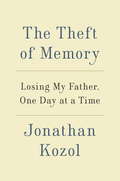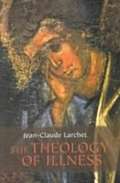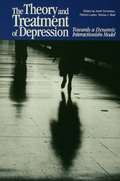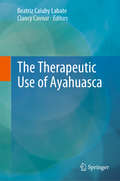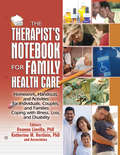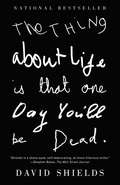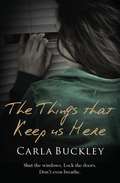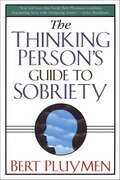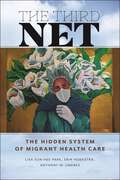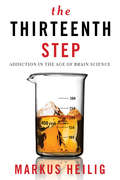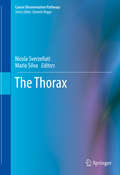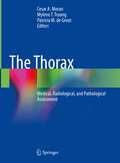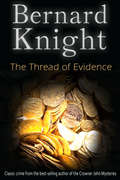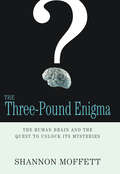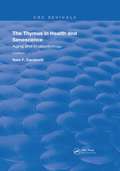- Table View
- List View
The Theft of Memory: Losing My Father, One Day at a Time
by Jonathan KozolNational Book Award winner Jonathan Kozol is best known for his fifty years of work among our nation's poorest and most vulnerable children. Now, in the most personal book of his career, he tells the story of his father's life and work as a nationally noted specialist in disorders of the brain and his astonishing ability, at the onset of Alzheimer's disease, to explain the causes of his sickness and then to narrate, step-by-step, his slow descent into dementia. Dr. Harry Kozol was born in Boston in 1906. Classically trained at Harvard and Johns Hopkins, he was an unusually intuitive clinician with a special gift for diagnosing interwoven elements of neurological and psychiatric illnesses in highly complicated and creative people. "One of the most intense relationships of his career," his son recalls, "was with Eugene O'Neill, who moved to Boston in the last years of his life so my father could examine him and talk with him almost every day." At a later stage in his career, he evaluated criminal defendants including Patricia Hearst and the Boston Strangler, Albert H. DeSalvo, who described to him in detail what was going through his mind while he was killing thirteen women. But The Theft of Memory is not primarily about a doctor's public life. The heart of the book lies in the bond between a father and his son and the ways that bond intensified even as Harry's verbal skills and cogency progressively abandoned him. "Somehow," the author says, "all those hours that we spent trying to fathom something that he wanted to express, or summon up a vivid piece of seemingly lost memory that still brought a smile to his eyes, left me with a deeper sense of intimate connection with my father than I'd ever felt before." Lyrical and stirring, The Theft of Memory is at once a tender tribute to a father from his son and a richly colored portrait of a devoted doctor who lived more than a century.From the Hardcover edition.
The Theological Voice of Wolf Wolfensberger
by William C Gaventa David CoulterDo people with mental retardation have a special prophetic role?In the field of developmental disabilities, Wolf Wolfensberger is famous for his seminal book Normalization. But Wolfensberger is also a theologian, and the two strands of his thought are inextricable. The Theological Voice of Wolf Wolfensberger showcases his theories on the spiritual meaning of mental retardation and other disabilities.Up until now, Wolfensberger's work has been available only in small, hard-to-find publications, mostly in the field of human services. Thus his theological perspectives have not yet been heard in many religious circles. The Theological Voice of Wolf Wolfensberger brings together his essays and presentations from the past thirty years, giving the reader a unique pathway into his pioneering ideas on the spiritual implications of developmental disabilities. In addition, the volume includes critiques of his thought by several noted scholars and practitioners, along with Wolfensberger's response to those critiques.The Theological Voice of Wolf Wolfensberger expresses powerful opinions, some outrageous, all courageous. You will find yourself intently engaged with his provocative theories, including: why installing wheelchair access ramps may actually block full participation of the handicapped in the life of the church how the “deathmaking” culture of the modern world prevents Christians from understanding the meaning of suffering why people with mental retardation are the prophets of our times why most Christians ignore the powerful Biblical call to communality which special gifts of grace people with mental retardation may possess how handicapped and societally devalued patients can be protected from the neglect (or worse) of hospital staff The Theological Voice of Wolf Wolfensberger is challenging, inspiring, and sometimes infuriating. It is bound to stir up controversy among health care professionals, disability advocates, and anyone concerned with spiritual matters. You may not agree with Wolfensberger, as some of the contributors to this volume do not, but he will make you think . . . hard.
The Theology of Illness
by Jean-Claude LarchetSt Augustine, from the Latin and Catholic tradition; St John Chrysostom, the Greek and Orthodox tradition; and Martin Luther, the Reformation and Protestant tradition. Together and yet separately, they illuminate both the Sermon and the speaker for anyone who still takes the challenge of faith, and language, seriously.
The Theory and Practice of Relational Coaching: Complexity, Paradox and Integration
by Simon Cavicchia Maria GilbertThe 'relational turn' is a movement affecting a range of disciplines including neuroscience, psychoanalysis, psychotherapy, organisational consulting and, more recently, coaching. Its primary focus is on the centrality of human relating in determining how individuals develop, make meaning and function individually and collectively. In The Theory and Practice of Relational Coaching: Complexity, Paradox and Integration, Simon Cavicchia and Maria Gilbert expand existing coaching theory and practice to focus on the implications of the relational turn for how coaches and clients think about the nature of identity, the self, change, learning, and individual and organisational development. Drawing on perspectives as varied as relational neuroscience, the relational foundations of personality development, psychoanalysis, psychotherapy, shame, vulnerability, complexity and systems ideas, the authors shed light on many of the paradoxes and challenges facing coaches and their clients in today’s fast-paced, volatile and uncertain organisational environments. These include holding tensions such as the uniqueness of individual needs with the requirements of organisational contexts, managing multiple stakeholder expectations and networks and balancing linear approaches to change with adjusting to emerging and unpredictable events. Given the ever-increasing volatility, complexity and uncertainty that coaches and their clients face, The Theory and Practice of Relational Coaching guides the reader through a series of illuminating perspectives, examples and practical suggestions. These will enable coaches to integrate a more relational orientation in their work and extend their range and that of their clients for responding creatively to the challenges of modern organisational life. The book will appeal to coaches and coaching psychologists in practice and training, as well as counsellors and psychotherapists retraining as coaches.
The Theory and Treatment of Depression: Towards a Dynamic Interactionism Model
by Patrick Luyten Sidney J. Blatt Jozef CorveleynRecent research indicates that depression, once believed to be relatively benign, is highly recurrent and does not respond well to treatment. The goal of this book is to facilitate the development of more encompassing theories and more effective treatments for this disabling disorder by fostering dialogue and enhancing the integration of work across the boundaries of separate fields.
The Therapeutic Relationship in Cognitive-Behavioral Therapy: A Clinician's Guide
by Judith S. Beck Nikolaos Kazantzis Frank M. Dattilio Keith S. DobsonFrom leading cognitive-behavioral therapy (CBT) experts, this book describes ways to tailor empirically supported relationship factors that can strengthen collaboration, empiricism, and Socratic dialogue and improve outcomes. In an accessible style, it provides practical clinical recommendations accompanied by rich case examples and self-reflection exercises. The book shows how to use a strong case conceptualization to decide when to target relationship issues, what specific strategies to use (for example, expressing empathy or requesting client feedback), and how to navigate the therapist's own emotional responses in session. Special topics include enhancing the therapeutic relationship with couples, families, groups, and children and adolescents. Reproducible worksheets can be downloaded and printed in a convenient 8 1/2" x 11" size.
The Therapeutic Use of Ayahuasca
by Beatriz Caiuby Labate Clancy CavnarThis book presents a series of perspectives on the therapeutic potential of the ritual and clinical use of the Amazonian hallucinogenic brew ayahuasca in the treatment and management of various diseases and ailments, especially its role in psychological well-being and substance dependence. Biomedical and anthropological data on the use of ayahuasca for treating depression, PTSD, and substance dependence in different settings, such as indigenous contexts, neo-shamanic rituals, contemporary therapeutic circles, and in ayahuasca religions, in both South and North America, are presented and critiqued. Though multiple anecdotal reports on the therapeutic use of ayahuasca exist, there has been no systematic and dense reflection on the topic thus far. The book brings the therapeutic use of ayahuasca to a new level of public examination and academic debate. The texts in this volume stimulate discussion on methodological, ethical, and political aspects of research and will enhance the development of this emergent field of studies.
The Therapeutic Use of Ayahuasca
by Beatriz Caiuby Labate Clancy CavnarThis book presents a series of perspectives on the therapeutic potential of the ritual and clinical use of the Amazonian hallucinogenic brew ayahuasca in the treatment and management of various diseases and ailments, especially its role in psychological well-being and substance dependence. Biomedical and anthropological data on the use of ayahuasca for treating depression, PTSD, and substance dependence in different settings, such as indigenous contexts, neo-shamanic rituals, contemporary therapeutic circles, and in ayahuasca religions, in both South and North America, are presented and critiqued. Though multiple anecdotal reports on the therapeutic use of ayahuasca exist, there has been no systematic and dense reflection on the topic thus far. The book brings the therapeutic use of ayahuasca to a new level of public examination and academic debate. The texts in this volume stimulate discussion on methodological, ethical, and political aspects of research and will enhance the development of this emergent field of studies.
The Therapeutic Use of N-Acetylcysteine (NAC) in Medicine
by Michael Berk Richard Eugene FryeFocusing on the practical use of N-Acetyl-Cysteine (NAC) in medicine, this book provides a comprehensive review of the basic biological and clinical studies documenting its benefits in treating medical disease. NAC is perhaps best known as an antidote for acetaminophen, but its therapeutic effect in a wide range of medical diseases has recently been realized. In addition to its well recognized use in radiological contrast prophylaxis for renal disease and pulmonary disorders, studies have suggested significant promise in psychiatric and neurological disorders such as addiction, Alzheimer’s disease, ataxia, autism, bipolar disorder, depression, epilepsy, neuropathy, obsessive-compulsive disorder, schizophrenia, traumatic brain injury and trichotillomania in addition to promising studies in audiology, cardiology, exercise physiology, gastroenterology, hematology, infectious disease, infertility and ophthalmology. Given the promising studies for a wide range of medical conditions, coupled with a excellent safety profile, the potential for NAC in the treatment of human disease appears considerable. Dr Leonore A Herzenberg from Stanford University, a pioneer of redox physiology and the use of NAC, provides a succinct history of the development of the therapeutic use of NAC for medical disease. This is followed by a series of basic science chapters outlining the role of NAC in important physiological processes, including modulation of dopamine and glutamate neurotransmitter systems, redox and mitochondrial metabolism, apoptosis and inflammation. The last section of the book is dedicated to clinically oriented chapters that comprehensively review the literature on medical disorders in which NAC has been found to be effective, including toxicity and cardiovascular, gastrointestinal, neurological, psychiatric, pulmonary and renal disorders. Each chapter reviews the theoretical biological mechanisms of NAC for the specific diseases reviewed, rates the clinical studies using a standardized criteria in order to provide an objective level of evidence and grade of recommendation for the use of NAC for specific medical conditions and outlines the ongoing clinical trials examining NAC for the treatment of specific diseases. Final chapters review the clinical evidence verifying that specific theoretical biological mechanisms are actually being targeted by NAC in medical disease. Studies on the pharmacology, formulation and potential adverse effects of NAC are also reviewed. A final chapter synthesizes the clinical studies to suggest that the effectiveness of NAC may signal a new basic physiological disorder, glutathione deficiency, which may be an important pathophysiological mechanism of many diseases.
The Therapist's Guide to Psychopharmacology, Third Edition: Working with Patients, Families, and Physicians to Optimize Care
by James L. Griffith Todd M. Edwards JoEllen PattersonNow in a revised and updated third edition, this noted practitioner guide and text incorporates the latest knowledge about psychopharmacology and collaborative care. Therapists and counselors learn when and how to make medication referrals and how to address patients' questions about drug benefits, side effects, safety, and more. Organized around frequently encountered mental health disorders, the book explains how medications work (including what they can and cannot accomplish). Strategies for collaborating successfully with patients, their family members, and prescribers are discussed in detail. Written for optimal practical utility, the text features case examples, sample referral letters, checklists, and a glossary. New to This Edition *Chapter on the therapeutic relationship. *New separate chapter on bipolar disorder. *Expanded discussions of distinguishing psychiatric illness from normal distress, optimizing collaboration with psychiatrists, how medications work in the brain, treatment of chronic pain, and more. *Additional case vignettes and psychopharmacology "rules of thumb."
The Therapist's Notebook for Family Health Care: Homework, Handouts, and Activities for Individuals, Couples, and Families Coping with Illness, Loss, and Disability
by Katherine M. Hertlein Deanna LinvilleEffective interventions to help your clients deal with illness, disability, grief, and loss The Therapist's Notebook for Family Health Care presents creative interventions for working with individuals, couples, and families dealing with illness, loss, and disability. This book offers creative resources like homework, handouts, and activities, and effective, field-tested interventions to provide counselors with useful information on specific family dynamics and topics. It equips mental health clinicians with practical therapeutic activities to use in their work with clients struggling with health care or grief issues. The effects of illness, disability, and loss in everyday life can be profound. Besides the individual repercussions, these challenges also affect the lives of the family and social networks of those individuals experiencing them. The Therapist's Notebook for Family Health Care brings together the knowledge and experience of over 30 experts in the field for a unique collection that therapists and clients alike will find immediately useful. Situated in four unique subject-specific sections for quick reference, this text covers a broad scope of common problems. Also included is a bonus section focusing on thoughtful suggestions for self-care and professional development. Some of the many topics and techniques presented in The Therapist's Notebook for Family Health Care include: conducting interviews using the biopsychosocial-spiritual method using the Family System Test (FAST) to explore clients' experiences with their healthcare system and providers increasing social support to manage chronic illness coping and adapting to developmental changes, challenges, and opportunities using a patient education tool in family therapy helping children (and their families) to manage pain through knowledge and diaphragmatic breathing creating a personal "superhero" for a child as a means to empowerment and relief of anxiety facilitating family problems using scatterplots building functional perspective of self and others in clients with Asperger Syndrome quilting as a meaning-making intervention for HIV/AIDS empowering terminally-ill patients to say goodbye to their young children in meaningful ways and many more!With a wealth of tables, charts, handouts, and bibliotherapy resources for clients; readings and resources for clinicians; and case vignettes, The Therapist's Notebook for Family Health Care is an excellent resource for a wide variety of practitioners, including, counselors, psychologists, social workers, grief workers, hospice workers, health psychologists, and medical social workers. It is also an ideal text for psychotherapy and counseling students and educators.
The Thing About Life Is That One Day You'll Be Dead
by David Shields“David Shields has accomplished something here so pure and wide in its implications that I almost think of it as a secular, unsentimental Kahlil Gibran: a textbook for the acceptance of our fate on earth. ” —Jonathan Lethem Mesmerized—at times unnerved—by his ninety-seven-year-old father’s nearly superhuman vitality and optimism, David Shields undertakes an investigation of the human physical condition. The result is this exhilarating book: both a personal meditation on mortality and an exploration of flesh-and-blood existence from crib to oblivion—an exploration that paradoxically prompts a renewed and profound appreciation of life. Shields begins with the facts of birth and childhood, expertly weaving in anecdotal information about himself and his father. As the book proceeds through adolescence, middle age, old age, he juxtaposes biological details with bits of philosophical speculation, cultural history and criticism, and quotations from a wide range of writers and thinkers—from Lucretius to Woody Allen—yielding a magical whole: the universal story of our bodily being, a tender and often hilarious portrait of one family. A book of extraordinary depth and resonance,The Thing About Life Is That One Day You’ll Be Deadwill move readers to contemplate the brevity and radiance of their own sojourn on earth and challenge them to rearrange their thinking in unexpected and crucial ways.
The Things That Keep Us Here: HOW DO YOU PROTECT YOUR FAMILY DURING A NATIONWIDE PANDEMIC?
by Carla BuckleyHOW DO YOU PROTECT YOUR FAMILY DURING A NATIONWIDE PANDEMIC?'The story of the Brooks family as they face a nationwide pandemic and fight to survive ... what an amazing read' Amazon reviewer 5 starsMillions are dead. Fear and panic have gripped the nation. An engrossing and emotionally gripping story of one family whose limits are tested to the extreme.It began with a dead bird. Then state-wide school closure. Before long, the whole town is in lockdown and the Brooks family are quarantined in their own home - with a faceless enemy on their doorstep.They must cope as best they can, battling hunger, cold and boredom. But as the threat inches closer, and neighbour turns against neighbour, single mother Ann doesn't know who she can trust - including those taking refuge in her house.With no end in sight, Ann knows that if she is to protect her daughters from untold danger, she must make impossible decisions in order to survive...
The Thinking Person's Guide to Sobriety
by Bert PluymenThis memoir of a high-functioning professional’s recovery from alcohol abuse “combines fascinating facts with intriguing stories” (John Bradshaw, New York Times–bestselling author of Healing the Shame that Binds You).Part autobiography, part recovery tool, this book is Bert Pluymen’s story of struggle and triumph over alcohol addiction. It also contains insightful, witty, uplifting, and wryly humorous stories of the many people Pluymen met who were also searching for sobriety. This is an informative book that will shed new light on how alcohol abuse can ruin people’s lives—even if they thought it could never happen to them.“A vital tool for awakening the alcohol-abusing professional.” —Dr. Frank Sadlack, Ph.D., executive director of La Hacienda Treatment Center“Plain talk and personal experiences make Bert Pluymen’s book a real guide for anyone whose life has been touched by addiction. The section on women [and alcohol] is especially good.” —Ann W. Richards, former governor of Texas
The Third Histamine Receptor: Selective Ligands as Potential Therapeutic Agents in CNS Disorders
by Divya VohoraReveals an Emerging Avenue of Potential Treatments for a Host of Challenging Diseases and DisordersThe H3 receptor is known to play a major role in a range of CNS disorders, including those affecting cognitive functions such as ADHD and Alzheimer's disease, as well as sleep disorders, obesity, epilepsy, schizophrenia, depression, and neurodege
The Third Net: The Hidden System of Migrant Health Care (Health, Society, and Inequality #5)
by Lisa Sun-Hee Park Erin Hoekstra Anthony M. JimenezReveals the presence of an informal system of valuable support and care for marginalized migrantsThe United States’ health care system not only consists of a formal safety net, but also an informal and disjointed network of organizations that offer basic care to millions of migrants. This “Third Net” provides free or low-cost health care for the undocumented, low-income, and uninsured migrants who are excluded from the formal system. This groundbreaking study sheds light on the existence of the Third Net and its implications for the overall inequalities in the US health care system.The Third Net is made up of diverse providers with varying levels of service, organizational culture, and mission. These providers operate in unconventional settings, such as mobile clinics on wheels; pop-up clinics in repurposed spaces; and unlicensed, makeshift clinics run by health activists. Despite their unassuming appearances, these clinics are vital resources for marginalized populations that often go unnoticed by the general public, revealing the shortcomings of our formal health care system.By examining these alternative health care spaces, the authors expose the inequities entrenched in the broader health care system and urge a reevaluation of it entirely in order to address these injustices.
The Thirteenth Step: Addiction in the Age of Brain Science
by Markus HeiligThe past thirty years have witnessed a revolution in the science of addiction, yet we still rely on outdated methods of treatment. Expensive new programs for managing addiction are also flourishing, but since they are not based in science, they offer little benefit to people who cannot afford to lose money or faith in their recovery.Clarifying the cutting-edge science of addiction for both practitioners and general readers, The Thirteenth Step pairs stories of real patients with explanations of key concepts relating to their illness. A police chief who disappears on the job illustrates the process through which a drug can trigger the brain circuits mediating relapse. One person's effort to find a burrito shack in a foreign city illuminates the reward prediction error signaled by the brain chemical dopamine. With these examples and more, this volume paints a vivid, readable portrait of drug seeking, escalation, and other aspects of addiction and suggests science-based treatments that promise to improve troubling relapse rates. Merging science and human experience, The Thirteenth Step offers compassionate, valuable answers to anyone who hopes for a better handle on a confounding disease.
The Thorax (Cancer Dissemination Pathways)
by Nicola Sverzellati Mario SilvaThis book highlights the differences, in terms of neoplastic dissemination pathways, between various types of thoracic cancers. It presents and discusses a comprehensive schematic overview of tumors of the lung parenchyma, of the mediastinum, of the pleura, and of the chest wall. For each tumor, it details the local spread and the lymphatic and vascular dissemination, and it describes the challenging staging of lung tumors with mutations. Illustrations and artwork enrich the content and help readers to understand and visualize tumor spread. The book is of great interest to professionals involved in the study, diagnosis and treatment of thoracic pathologies, as well as to residents in radiology, oncology and pulmonology.
The Thorax -- Part A: Physiology (In Three Parts), Second Edition (Lung Biology in Health and Disease)
by Charis RoussosThis book provides a comprehensive, authoritative, and contemporary discussion of the physiology and pathophysiology of the chest wall as well as an overview of the diagnostic and therapeutic modalities. It is an invaluable aid to clinical investigators.
The Thorax, ---Part B: Applied Physiology (In Three Parts)
by Charis Roussos Theodoros VassilakopoulosThis timely Second Edition of a landmark reference furnishes in-depth examinations of the latest developments in the physiology, pathophysiology, and clinical relevance of the respiratory muscles and chest wall-reflecting the explosion of information that has occurred since the publication of the previous edition.
The Thorax: An integrated approach
by Catherine Ryan Diane Lee Nancy Keeney SmithThis clinical textbook will update the reader on the relevant anatomy, known biomechanics, clinical assessment, musculoskeletal conditions and treatment of the thorax and how these relate to the function of the whole body. An integrated biopsychosocial model (the Integrated Systems Model - ISM) will be highlighted in this text and used as a foundation for clinicians to organize their knowledge from multiple sources. The text emphasizes the current suggestion from the evidence that treatment be individualized and that clinical reasoning form the basis for treatment decisions.Richly illustrated with 3D-rendered colour anatomical drawings, and over 250 clinical photographs, The Thorax: An integrated approach is the definitive manual on the thorax for all bodyworkers helping patients improve mobility and control of the trunk.
The Thorax: Medical, Radiological, and Pathological Assessment
by Cesar A. Moran Mylene T. Truong Patricia M. de GrootThe current medical practice has become more of a team effort rather than an isolated practice. The current evaluation of patients in the daily practice is essentially performed by medical assessment of the patient in question followed by diagnostic imaging, and when needed and possible the evaluation of tissue for diagnosis with its subsequent assessment of biomarkers and other ancillary tools that play an important role in the evaluation and prognosis. The book herein proposed will exactly provide such assessment focused in the thoracic assessment of patients afflicted with any particular disease of the thorax. Expert clinician in pulmonary medicine will provide the state of the art in the evaluation of such patients, which will provide the most important background in the clinical impression and further assessment of these patients. This assessment in most cases is followed by the evaluation of imaging, which provides a highly important information of not only the exact location of the process but also of the nature of whether is localized, infiltrative, diffuse, bilateral, etc., as well as the possible compromise of other adjacent structures. Such information is crucial as imaging and clinical information will provide a working diagnosis, which ultimately will be defined by the pathological assessment. Therefore, in real practice neither one of these subspecialties works alone or in isolation. On the contrary, each one depends on the other for the final diagnosis and proper management of patients with thoracic diseases. Based on such experience is that the current text will provide in the same text of the needed information that a clinician, radiologist or pathologist will need in order to arrive to the best possible conclusion. The scope of this book is unique in its nature as currently, even though there are several text on either one of those specialties, those publication are strictly on the either radiology, medicine or pathology. Our proposed text will bring all those together in a single text and written by experts in their respective field. This book should be of interest to all of those in the practice of thoracic medicine (radiologist, pulmonologist, pathologists) and any one who in the general practice is confronted with the evaluation of these patients.
The Thread of Evidence: The Sixties Crime Series (The\sixties Crime Ser. #2)
by Bernard KnightA classic murder mystery by acclaimed author Bernard Knight.When some boys find a human bone in a cave in Cardiganshire, Wales, a case that has gone unresolved for over thirty years suddenly springs back into life. For that grisly find is only the start of things...When the rest of the skeleton is soon discovered, the disappearance of a local woman decades earlier comes back to public attention. The woman’s husband has recently returned to the area after years out of the country, and he has no explanation as to why his wife suddenly went missing. The local gossips consider him guilty of murder, as do some in the police force…but not everyone is convinced. It’s up to Superintendent Pacey to work out which bits of the whole sorry tale are fact and which are fiction – and there are some unpleasant surprises along the way…
The Three-Pound Enigma: The Human Brain and the Quest to Unlock Its Mysteries
by Shannon MoffettThe average human brain weighs three pounds—80 percent of which is water—and yet it's capable of outstripping the computational and storage capacities of the most complex computer. But how the mind works remains one of humankind's greatest mysteries. With boundless curiosity and enthusiasm, Shannon Moffett, a Stanford medical student, takes us down the halls of neuroscience to the front lines of cutting-edge research and medicine to meet some of today's most extraordinary scientists and thinkers, all grappling with provocative questions: Why do we dream? How does memory work? How do we see? What happens when we think? Each chapter delves into a different aspect of the brain, following the experts as they chart new ground. Moffett takes us to a lab where fMRI scans reveal the multitude of stimuli that our brains unconsciously take in; inside an operating room where a neurosurgeon removes a bullet from a patient's skull; to the lab of Christof Koch, a neuroscientist tracking individual neurons in order to crack the code of consciousness; and to a research lab where scientists are investigating the relationship between dreams and waking life. She also takes us beyond the scientific world—to a Zen monk's zendo, where she explores the effects of meditation on the brain; inside the home of a woman suffering from dissociative identity disorder; to a conference with the philosopher Daniel Dennett, who uses illusions, magic, tricks, and logic to challenge our assumptions about the mind; and to the home of the late Nobel Laureate Francis Crick, co-discoverer with James Watson of DNA's double-helix structure. Filled with fascinating case studies and featuring a timeline that tracks the development of the brain from conception to death, The Three Pound Enigma is a remarkable exploration of what it means to be human.
The Thymus in Health and Senescence: Volume 2 Aging and Endocrinology (Routledge Revivals #2)
by Nathan F. CardarelliFirst published in 1989: This text was written to provide a relatively broad comprehensive study of the thymus in health and disease, including relationships to the endocrine system, immue system, and again.
